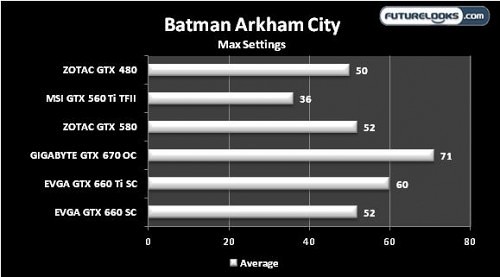Batman Arkham City
Batman Arkham City puts more emphasis on NVIDIA PhysX and the power of the GPU with it enabled. The GTX 660 scores about 8 frames less than the GTX 660 Ti, but scores a whopping 16 FPS better than the outgoing GTX 560 Ti. 52 fps for the GTX 660 is also very playable at 1080p. Despite their former excellence, both the GTX 5xx series Fermi cards just don’t have the optimizations like Kepler so they have to rely on their raw bandwidth to keep up. It’s interesting to see the GTX 660 at $199, still keep up with a GTX 580 which is still available on clear out for nearly $100 more.
While GTX 580 is technically a stronger card for direct compute and CUDA based apps, the GTX 660 is definitely more efficient as a gaming card, which is what NVIDIA designed it to do.
STALKER Call of Pripyat
This benchmark moves a lot of data. The more numerous cores, faster memory, and frequencies assist the GTX 660 very well. The card isn’t much slower than the GTX 660 Ti in everything but the Rain test. Pretty darn good for a $199.99 to $229.99 priced card. We also now start to see just how efficient the GTX 660 can be when paired with the right title. Anything Fermi based really starts to fall off now.
Battlefield 3
In my demo, a lot more PhysX and movement is going on which pushes my test GPUs pretty hard. The GTX 660 was only a mere 7 frames slower than the GTX 660 Ti which is really not half bad at all. It keeps up with the beefy Fermi cards as well. This is good news for BF3 fans that are looking for something more capable at a reasonable price. With over 22 more FPS over the GTX 560 Ti, it really does make it a potentially worthy upgrade if your game of choice is this title.
Aliens vs Predator Benchmark
As expected, the GTX 660 SC stays close on the heals of the GTX 660 Ti SC. With all the tessellated video action going on with this benchmark, this is a very decent score. Overclocking the card did add about another 9 FPS to the score in offline testing.
This benchmark also shows that older titles may not benefit as much from the upgrade, similar to what we found in Metro 2033. It’s clear that if you play the newest games, then the upgrade to GTX 660 is worth it. But if you still play a large number of older games, and are still getting reasonable frame rates, the upgrade choice is a tougher one.
Final Thoughts
When it comes down to it, the GTX 660 and 660 Ti are technically twins. But aside from the number of cores, and memory, nearly $100 separates the two GPUs in price. So is that $100 worth it?
While the GTX 660 Ti is more powerful and has more resources to handle more demanding games and potentially applications, the GTX 660 SC makes great use of its higher frequencies to help provide very playable frame rates even when using higher graphical settings. Surprisingly, the GTX 660 is on par with its beefier Fermi cousin, the GTX 580. But as shown in our benchmarks, the difference between the Fermi and Kepler architecture all come down to whether you play the newest games or not. Kepler is clearly more efficient and better optimized as the titles get newer.
Getting to our subject card specifically, EVGA GTX 660 Superclocked is a quiet, and capable gaming experience. The card is a fraction of the former Fermi’s weight and utilizes its resources very efficiently. This means that, as an upgrade, the card is easier to deal with and doesn’t require a larger power supply, increasing your upgrade costs. While single card configurations won’t get too hot or loud, SLI may put them in very close proximity on some boards, which may limit the air flow of the “reference style” cooler. But that’s only a concern if SLI is in your future.
The GTX 660 is a great value especially if all you really need is a single GPU solution that plays at 1080p resolutions well, and especially if you’re finding that you’re playing today’s newer titles. This is evident in titles like Battlefield 3 where this card is matching top end Fermi GPUs still on shelves for higher prices. It’s also pretty apparent that at $100 less than the GTX 660 Ti, you certainly aren’t losing that amount in gaming performance. We highly recommend it for its great value starting at the $199 sweet spot for a great gaming card.
Our $229 EVGA Superclocked GTX 660 isn’t too shabby either if you want something better than a vanilla stock card. Especially with the great warranty.
Pros
- Relatively high end performance with today’s game titles
- Great cost-performance ratio at $229.99
- Cool and quiet Kepler operation
- Precision X overclocking utility
- Single 6pin power required!
- Cross shipping RMA support
- Warranty: 3 Year standard, 5 Year and 10 Year upgradable
Cons
- Won’t please overclocking enthusiasts
Overall Rating: 9.0 / 10.0


Help Us Improve Our Reviews By Leaving a Comment Below!






